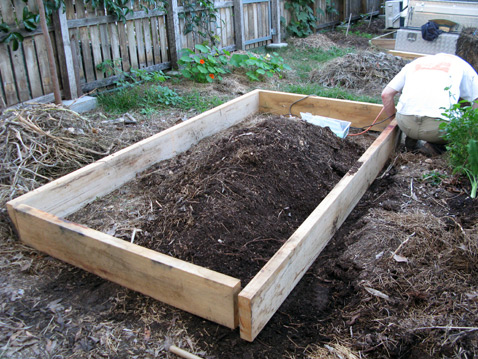Here's what a bale looked like once decomposed. I think this one was lucerne.
You can see the blue baling twine mixed in with the rotted bits of lucerne (and some opportunistic tomato seedlings) as well as the even-more-well-rotted remains of the bale. Lots of fabulous compost, yes. Garden edge? Not any more.
Over summer, the vegie garden as a whole got a bit buggy, and then overrun with pumpkin. Anything leafy (like the spinach, purple sprouting broccoli and kale) got infested with cabbage moths and aphids, and the whole thing was in a rather sorry state. I let the pumpkin do its thing and then a month ago the whole vine suddenly went yellow and died, prompting me to harvest about eight good-sized pumpkins, and a stack of smaller ones that had stopped developing but proved to still be edible.
With the absence of pumpkin the garden revealed itself - or should I say, the lack of garden revealed itself. All I had left of the first garden (I had made two, the first before last winter, and another before last summer) was a very large pile of ex-garden that began to slide alarmingly down the yard with every bit of rain. (Curiously, one such slide did reveal a secret crop of sweet potatoes who had been lurking beneath the pumpkins.) But action was required, and as usual, C came up with the necessary arm strength.
Here it is - a simple wooden edge using untreated timber. Getting untreated timber is important (it was ordered in by the timber merchant as they didn't have it in stock) as I don't want any of the chemicals used to preserve timber to leach into the soil and therefore into our vegies.
I should add here that the reason that I didn't dig that compost straight into the ground is that we live in an area where the natural soil is not soil at all - it's solid clay, and so any garden needs to to be built up on top of it for best chance of success.
Anyway, C made me two lovely timber-edged beds, which take up about the same area as one of the original straw-bale-edged beds. I admired his handiwork for a while and then took a look at what remained from the original bed. After pulling out all the blue baling twine, I mixed up the decomposed bales with the original 'lasagne' from the no-dig bed - the layers of lucerne, compost, manure, straw and Hydrocell. Here's what's left:
A lovely mulchy mix, full of little munching insecty bugs (and some of those appalling Gigantor lawn grubs that even the chooks have difficulty touching, let alone eating) and well-rotted straw, and even some of the original Hydrocell (above, that's the big white clump) water-retaining stuff.
So, this year I'm going with a tweaked version of Stephanie's no-dig lasagne recipe from last year. I put a thick layer of cardboard down on the ground first, (under the edges of the timber, to stop grass coming through) followed by a layer of lucerne in chunks about ten centimetres thick. Over the top of that I spread the remainders from last year - that's the big pile you can see in the photo above. That just about filled the timber to the top - but it will all settle quite a lot, so I kept piling stuff on.Four bags of sheep manure, followed by two big bags of Searle's Compost Mix. I love the Searle's Compost Mix - it's got fish and seaweed and worm castings already added to the compost, making it a very rich mix. I grew last year's potatoes in it, neat, and they were grand!
I then forked the whole lot over gently, taking care not to disturb to the lucerne layer. A bit of water to help it settle and I think this will be ready to start planting. I'm keen to get some greens in - and very interested to see how this works compared to last year. I hope to have good things to report in a few weeks - fingers crossed, hey?






1 comment:
Looks great and I think it will work really well. It's very similar to the beds I did with my girls and they are going well. Good luck!!
Post a Comment